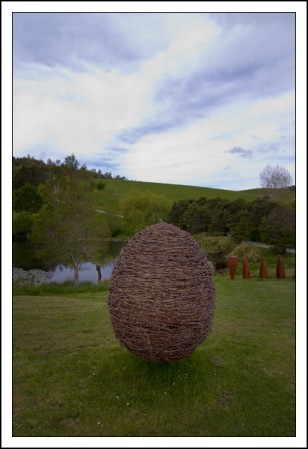
Corrugated metal shavings curl up above a pond at the Brick Bay Sculpture Trail. Photos by David Lansing.
The Matakana Farmers Market was founded by a guy named Richard Didsbury and I’d be lying if I told you everybody in town loves him. The thing is, Richard is a very wealthy developer (because of the negative connotations, he hates being called that, preferring something like “investor,” but he is what he is). So here’s the quick story: Didsbury and his wife, Christine, first came to Matakana in the mid ‘80s when they bought some land where an old brickworks used to be and, in 1995, planted vineyards. They are also big patrons of the arts and in 2004, started construction on a Sculpture Trail next door to showcase contemporary sculpture in an outdoor setting.
You do stuff like this and some people are going to love it and some people are going to say you’re getting a bit too big for your britches (and, let’s be honest, most of that sort of criticism comes wrapped in envy). Now, if Didsbury had just stuck with the winery and Sculpture Trail, people probably would have gotten over it. But he didn’t. Didsbury had a vision of the way he thought Matakana should be. He wanted it to be both native and exotic, historical and contemporary, small-town but vibrant. Those are hard things to balance. In 1992, he bought a big chunk of real estate right at the entrance into the village of Matakana and sat on it for a few years trying to figure out what he wanted to do with it.
Eventually he brought in a well-known architect, Noel Lane, who has a reputation for building cutting edge, contemporary buildings. Which scared the hell out of a lot of the locals. Because at this point the town was kind of divided in half. There were the farmer/fishermen/crafts people whose families had been here for decades (think dairy farm co-op) and then there were the newbies who were basically Auckland refugees with money who came here for the beauty of the place and its small-town vibe but, frankly, also wished there were better restaurants in town and a place where you could watch foreign films.
As one observer put it, “The Matakana Coast is to Auckland what the Hamptons are to New York—a sort of rich people’s Woodstock. Every Friday afternoon, Auckland to Matakana is an unbroken procession of BMWs, Mercedes, and Jaguars ferrying people with expensive haircuts to weekenders with stainless-steel commercial kitchens and 15-metre-high sky domes. For them, Matakana offers the simple, natural informality of teaming Bulgari eyewear with bare feet. Its beaches, bays, and islands make it a natural habitat for sleek yachts and floating gin palaces.”
Okay, that may be a bit harsh, but you get the idea.
So Didsbury comes in, buys a big chunk of the old village and eventually builds a pretty eye-popping complex that includes art galleries, wine bar, and a stunning boutique cinema where one of the theaters has 32,000 paper flowers stuck on the ceiling. You can see how not every sheep farmer and blueberry grower in town is going to go crazy over the transformation. And why Heather, back at Takatu, says with a sly grin that meetings at the school house “can get a little animated” at times. I’ll bet.
 Anyway, I love what Richard Didsbury has done. The Village Complex he developed with Noel Lane is brilliant. It is both of the past and of the future at the same time. And the second smartest thing he did was to donate the land, next to the Village Complex, for the Farmers Market. And that was brilliant as well. Some old timers may grumble about folks coming in selling handmade mustard and special cheeses to all the day-trippers from Auckland, but they’re missing the point: The town has taken on a new life, culturally and economically, since Richard and Christine Didsbury arrived. And this is a good thing.
Anyway, I love what Richard Didsbury has done. The Village Complex he developed with Noel Lane is brilliant. It is both of the past and of the future at the same time. And the second smartest thing he did was to donate the land, next to the Village Complex, for the Farmers Market. And that was brilliant as well. Some old timers may grumble about folks coming in selling handmade mustard and special cheeses to all the day-trippers from Auckland, but they’re missing the point: The town has taken on a new life, culturally and economically, since Richard and Christine Didsbury arrived. And this is a good thing.
This is all prelude to say that yesterday afternoon, I went out to the Didsbury’s Brick Bay Sculpture Trail and roamed, on my own, along the 2km trail that takes you past lily ponds where corrugated metal shavings curl up over the water like strange iron birds and six-foot high Easter egss, made of branches, sit whimsically in the middle of a field. I loved it. Every time I came around a bend, there was something just out there—in the woods, the meadows, the ponds—that both made me smile and made me think. It was, just like Didsbury’s other projects, absolutely brilliant.
Tags: Matakana, New Zealand

Recent Comments